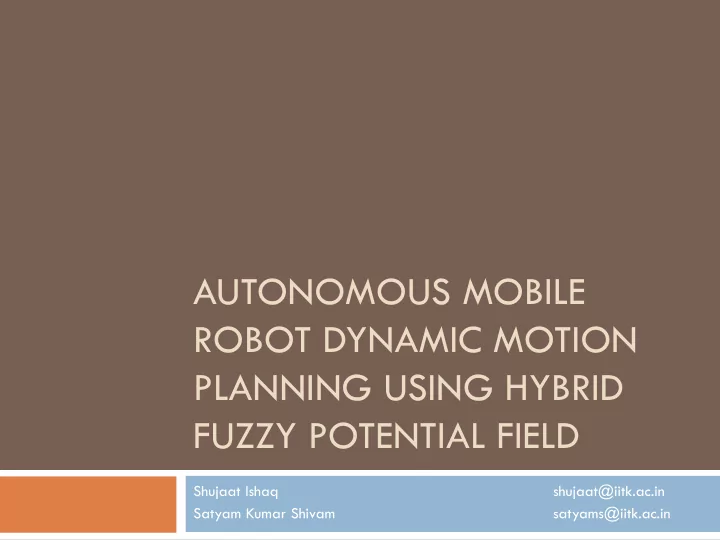

AUTONOMOUS MOBILE ROBOT DYNAMIC MOTION PLANNING USING HYBRID FUZZY POTENTIAL FIELD Shujaat Ishaq shujaat@iitk.ac.in Satyam Kumar Shivam satyams@iitk.ac.in
Description Problem Autonomous Robot Motion Planning Moving target and Obstacles Soft Landing Assumptions Fully Observable Single Agent
Model [5]
Model Attractive force due to a target depends on Relative position Relative velocity ����� = � × � � × ∆� + � × � � × ∆� � ����� = � × � � × ∆� + � × � � × ∆� � Computationally expensive [5] Modeled using Mamdani fuzzy Inference System Fuzzy input variables { ∆x , ∆y , v x , v y } Triangular Membership function
Mamdani Fuzzy Inference 4 step method Fuzzification of input variables { -large, -small, zero, +small, +large} Rule evaluation 4 set of rules R1: IF ∆x is _ THEN Fatt_x is _ R2: IF v x is _ THEN Fatt_v x is _ R3: IF ∆y is _ THEN Fatt_y is _ R4: IF v y is _ THEN Fatt_v y is _ Aggregation of rule outputs [5]
Mamdani Fuzzy Inference [6]
Mamdani Fuzzy Inference Defuzzification Final output of a fuzzy system has to be a crisp number Centroid Locate the point where a vertical line would divide the aggregate set into two parts of equal areas.
Model Repulsive force due to an obstacle depends on Relative position Relative velocity [5] Modeled using TSK fuzzy Inference System Fuzzy input variables { ∆x , ∆y } Gaussian Bell Membership function
TSK Inference Similar to Mamdani except for the rule evaluation part. Michio Sugeno suggested to use a single value as the membership function instead of a slice as used in Mamdani. IF ∆x is _ and ∆ y is _ THEN f repulsive = a i ∆x + b i ∆y+ c i How to determine a i , b i and c i ? ANFIS
TSK Inference [5]
ANFIS Adaptive Neuron Fuzzy Interference System [4]
Adaptive Neuron Fuzzy Inference System (ANFIS) Layer 1: Each node is an adaptive fuzzification node. Gaussian bell membership functions α i , β i & m i are the modifiable parameters to be tuned by the network. 11 membership functions for each input.
Adaptive Neuron Fuzzy Inference System (ANFIS) Layer 2: Firing strength of each rule is determined using the T norm Operator. Product T norm Operator Layer 3 normalizes the fired strength calculated from layer 2 over all nodes within this layer. .
Adaptive Neuron Fuzzy Inference System (ANFIS) Layer 4 is also an adaptive layer. Each node output is obtained using normalized weighted output of the linear fuzzy TSK IF-THEN rule of the following form. The parameters (a i , b i , c i ) are tuned during the training phase. Layer 5 sums all the normalized weighted outputs from the previous layer. Thus a final crisp value is obtained at layer 5.
DATASET The training data set is gathered by simulating the repulsive force model presented in [1](Ge and Cui 2002). Difficult to generate a dataset that completely represents the dynamic system. Quantization of the work space of the mobile robot is done to limit the size of training set. Uniformity along all directions is ensured to prevent bias.
ANFIS Learning Algorithm ANFIS uses two sets of modifiable parameters say A1 and A2. A1 represents the parameters of Gaussian bell membership functions used in Layer 1. A2 represents the coefficients of the linear functions as in Layer 4.
ANFIS Learning Algorithm ANFIS uses a two pass learning cycle. Forward pass A1 is fixed and A2 is computed using a Least Squared Error algorithm Backward pass A2 is fixed and A1 is computed using a gradient descent algorithm.
Local Minima Problem (LMP) Many ANFIS model has been chosen for optimal number of input membership functions so as to solve LMP. Finally, the ANFIS model with 15 membership functions solves the local minima problem. [5]
References 1. Ge SE, Cui YJ (2002) Dynamic motion planning for mobile robots using potential field method. Autonomous Robots 13:207–222. 2. Jang J-SR (1993) ANFIS: adaptive-network-based fuzzy inference system. IEEE Trans Syst Man Cybern 23:665–685 4. http://homepages.rpi.edu/~bonisp/fuzzy-course/Papers-pdf/anfis.rpi04.pdf 3. Matlab Inc. (2008) Matlab fuzzy logic toolbox.http://www.Mathwork.com 5. Jaradat, Mohammad Abdel Kareem, Mohammad H. Garibeh, and Eyad A. Feilat. "Autonomous mobile robot dynamic motion planning using hybrid fuzzy potential field." Soft Computing 16.1 (2012): 153-164. 6. http://www.4c.ucc.ie/~aholland/udg/Girona_Lec5.pdf
Any Questions ??
Recommend
More recommend